
Ever since the Trump Administration kicked off a trade war with China, there have been questions about what kinds of impact this could have on the consumer electronics market. The Consumer Technology Association has released its own report estimating the potential impact if the Trump Administration’s latest round of tariffs on $300B worth of additional Chinese goods goes into effect.
Before we dive in, here’s the current state of play. The US and China seemed to be near an agreement earlier this year that would resolve the earlier rounds of the trade war when the Chinese reportedly made significant negative changes to their negotiating position (from the US perspective). The US has threatened to add a 25 percent tariff to an additional $300B worth of Chinese goods as a result. When combined with the tariffs already levied against Chinese goods now, the end result would be a tariff on virtually all Chinese imports, including finished computers and cell phones — two categories that had previously been excluded.
The CTA is a business trade organization and can be assumed to be generally anti-tariff — but this doesn’t mean the organization’s estimate of the short-term or long-term effects of a tariff spike is wrong. It is, however, something to be aware of as we evaluate the results.
The CTA predicts that the price of importing a smartphone from China would rise by 1.22x. China accounts for approximately 3/4 of our total smartphone imports. It is not clear if this report takes into consideration recent statements like that from Foxconn, which claims it can meet demand for US iPhones from non-Chinese sources. (The CTA report does consider the idea that manufacturers will move production into non-Chinese facilities, but does not break down what it believes individual companies will do in response to a potential $300M tariff).
Korea and Vietnam would benefit from increased export revenues related to stronger phone imports for US markets, but US consumers would pay $8.1B more for smartphones. The CTA predicts a net $4.5B economic loss even after calculating the benefits of the tariffs themselves.
Tablets are hit by similar metrics. Prices would rise an estimated 1.19x, leading to a 1.35x reduction in consumption. Because there’s virtually no US-based tablet production (mirroring the situation in smartphones), there would be no gain to net American manufacturing. I trust the CTA as far as these conclusions are concerned — America doesn’t build smartphones or tablets, and very few computers are actually assembled here. Tariffs can be used to boost domestic production at the expense of international trade, but not if you don’t have a domestic base to begin with.
Estimated impact of new tariffs on laptops and tablets.
The organization predicts broad price gains of 1.19x – 1.22x in video games, tablets, smartphones, and drones. None of the tariffs result in a net positive outcome for US manufacturers because the US doesn’t manufacture most of these products. Prices on laptops could rise by $150, while tablets could jump $50.
I suspect the real-world outcome, should these tariffs go into effect, will be more nuanced than what the CTA outlines — and may possibly be impacted by the ongoing Huawei situation as well. The United States’ efforts to strangle this Chinese company are far more unusual than saber-rattling over tariff levels, and I can’t imagine that it isn’t a major bargaining chip in the negotiations between US and Chinese officials.
My own guess is that we’ll see companies try to buffer the impact of these tariffs on some products, where they can absorb some or all of the impact, while passing them straight along to customers on products where profit margins are low and there’s no room to eat the cost. At the same time, every company with the ability to move production out of China to dodge tariffs will do so.
In the long term, this will presumably produce some ability to move back towards pricing baseline, as new production comes online. Diminished demand for Chinese-manufactured products could reduce their prices, thereby also reducing the relative size of the tariff they incur. Not everyone will be able to move production out of China, at least not right away, and so at least some of the concern about the possibility for a global trade slowdown is real.
Of course, there are other concerns to be balanced as well. One might argue that the value of a cheap 4K TV is less important than retaining the technological edge that allows US companies to continue pushing the envelope on technology as a whole. Forced technology transfers and IP theft have both been major concerns of the Trump Administration and the Obama Administration before it, but the TA has chosen to be much more aggressive in how it attempts to deal with these problems. Some have pointed out that this strategy could backfire long-term if it encourages China to divest from working with the US altogether long-term and sets the stage for the two largest economies on the planet to be at economic war with each other rather than continuing to cooperate.
There is merit in considering all of these points. Trade is a complex and multi-faceted topic. There has been a note of uncertainty in the world economy regarding these issues, and various financial institutions would clearly prefer to see them amicably resolved. The CTA’s analysis of the economic harms of tariffs should be treated with a grain of salt, but it does at least provide a window into what the results might be.
Now Read:
- Second Apple Engineer Caught Stealing Trade Secrets for Chinese Companies
- Western Digital Freezes Out Huawei, Which Braces for Massive Sales Drop
- Tech Stocks Jittery as New Chinese Tariffs Loom
 #Bizwhiznetwork.com Innovation ΛI |Technology News
#Bizwhiznetwork.com Innovation ΛI |Technology News




